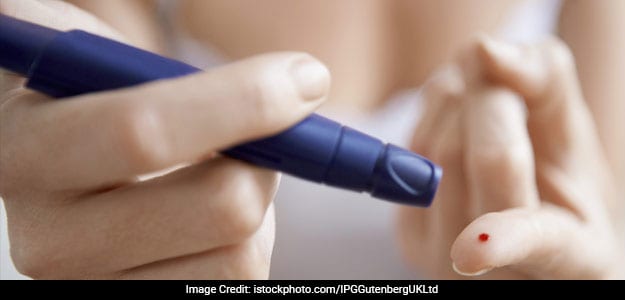Diabetes mellitus dis
Diabetes mellitus guide
Diabetes mellitus
What is it?
Diabetes mellitus (DM) is the body's inability to regulate the level of glucose in the blood. Glucose is the main form of sugar in the body. The body breaks down food into glucose and uses it as a source of energy. In healthy people insulin helps to regulate the glucose (sugar) levels. Insulin is a hormone produced by the pancreas (a long, thin organ located behind the stomach against the back). In diabetics, the body does not produce enough insulin or does not use the produced insulin effectively. This results in a high level of glucose in the blood ("hyperglycaemia"). There are four main types of diabetes mellitus:a) Type 1, earlier known as insulin dependent diabetes mellitus (IDDM) or juvenile-onset diabetes mellitus. People with this type of diabetes make little or no insulin in their body, and need regular insulin injections for survival and management of diabetes. It usually starts in childhood, but can occur at any age. b) Type 2 (DM2), earlier known as non-insulin dependent diabetes mellitus (NIDDM) or adult-onset diabetes. This is the most common form of diabetes, and is strongly associated with genetic tendency and obesity. The body produces normal or even high levels of insulin, but certain factors make its utilization ineffective ("insulin resistance"). Sedentary lifestyle, unhealthy dietary patterns, and the consequent obesity are common causes. It usually starts in adulthood, but is beginning to be seen in obese adolescents also. c) Gestational diabetes mellitus, or pregnancy-induced diabetes. d) Secondary diabetes mellitus, caused by genetic conditions, pancreatic diseases (e.g. inflammation, surgery or malignancy of the pancreas, etc.), drugs (e.g. steroids like prednisolone, pentamidine, excess thyroid hormone, etc.) or other medical conditions (acromegaly, Cushing syndrome, pheochromocytoma, hyperthyroidism, congenital rubella, etc). Medications such as thiazide diuretics or oral contraceptives can precipitate diabetes in a person predisposed to get it later.
What are the symptoms?
Symptoms depend on the type and duration of diabetes. Some of the signs and symptoms are related to the high blood sugar levels. These include: Increased urination Increased thirst HungerOther common symptoms: Fatigue Blurred vision Urinary and vaginal infections Skin infections, especially fungal or more serious bacterial infections Frequently upset stomach, stomach pains, nausea and vomitingThere may be weight loss, especially if the amount of insulin made by the body is decreasing. If insulin deficiency is marked, the person can become drowsy and then go into coma. This is called Ketoacidosis, and usually occurs in DM1. Rarely, if the diabetes is completely out of control, it can also occur in DM2. Other symptoms of ketoacidosis include: Deep rapid breathing, sometimes with a fruity odour to the breath Pain in the stomach, with nausea and vomiting
How is the diagnosis made?
Diabetes mellitus is diagnosed based on a high level of glucose or sugar in the blood. The doctor may suspect diabetes mellitus after taking the medical history and doing a physical examination. There are several blood sugar tests used for diagnosis: Fasting plasma glucose test: In this test, a person is asked to fast overnight, at least 8 hours, and the level of glucose in the blood is then checked. Normal fasting plasma glucose levels are less than 110 mg/dl. A fasting plasma glucose level of more than 126 mg/dl usually indicates diabetes mellitus. A level of 110-125 mg/dl is called "impaired fasting glucose".Post prandial (PP) plasma glucose: This is tested two hours after having a meal, which serves as a challenge for the body to regulate the blood sugar. Normal PP levels are <140 mg/dl; a glucose level of more than 200 mg/dl indicates diabetes mellitus, while a level between 140-199 mg/ dl is called "impaired glucose tolerance". Random plasma glucose test: is that which is done at any other time. A level of 200 mg/dl or higher generally indicates the presence of diabetes.Oral glucose challenge test (oGTT): The blood glucose is tested 2 hours after giving 75 gm glucose by mouth. This is useful for detecting borderline diabetes and a condition called "impaired glucose tolerance".Oral glucose tolerance test: is the preferred way to diagnose pregnancy-induced diabetes. Ideally all pregnant women in India should have a blood glucose test done 30 minutes after taking 50 gm gluocse (screening test). If this is abnormal, the lady should undergo an oGTT: with 100 gm glucose (not the conventional 75 gm). Blood samples are then drawn at intervals of one hour upto 3 hours (ie at 1, 2 and 3 hours post-glucose).
What is the treatment?
The treatment of diabetes depends on the type of diabetes. It is aimed to decrease symptoms and prevent complications such as low blood sugar levels (hypoglycemia), eye problems, kidney disease, and nerve damage.DM1 needs treatment with insulin injections to replace the insulin that is not produced in the body. There are several types of insulin available. The most commonly used are the genetically engineered that are similar to human insulin. The difference in the various types of insulin is the times at which they "peak" or are most effective. Insulin schedule depends upon the meal pattern of the individual. This is required to avoid low blood glucose levels, causing hypoglycaemia. Insulin is administered with a syringe, and newer devices such as insulin pens and insulin pumps. The latter devices control diabetes more efficiently.DM2 (earlier called NIDDM) is initially treated with weight reduction, diet control and regular exercises. When these measures fail to control the blood sugar levels, oral medicines are used. Sulphonylureas are a group of drugs that stimulate the release of insulin from the pancreas. Metformin reduces insulin resistance, and the production of glucose by the liver. Thiazolidenediones also increase insulin efficiency and sensitivity. Acarbose delays the absorption of glucose by the intestines. When the action of oral drugs is insufficient, insulin injections are added.Exercise: It is an important component of diabetes therapy. Exercise utilizes blood sugar and makes the body more sensitive to insulin. It also reduces high blood pressure and high lipid levels, which are often associated with diabetes.Diet: There is no such thing as a "diabetic diet". Persons with diabetes should eat a normal, balanced diet, which is designed to meet their nutritional requirements, maintain normal blood sugar levels and at the same time to help in achieving appropriate weight (i.e. reduction in case of obese persons, regain in case of very lean persons). It is also important to eat meals at regular time intervals, especially if insulin is used.
Diabetes mellitus News More News
FAQ Related to Diabetes mellitus
- I am diabetic; can I take jaggery?
- What is the cause for high ESR?
- Is my diabetes due to insulin deficiency or insulin resistance?
- Why does my brother have low platelet count?
- Am I taking correct treatment for focal segmental glomerulosclerosis (FSGS)?
- What care should be taken by a pre-diabetic while planning a baby?
................... Advertisement ...................
................... Advertisement ...................
................... Advertisement ...................
................... Advertisement ...................





















